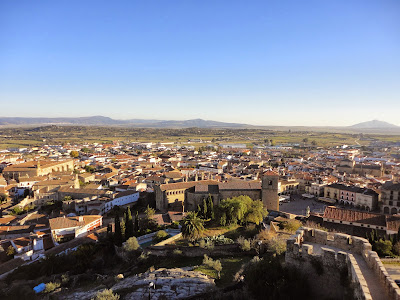Extremadura isn't exactly a top tourist destination. It's probably one of the most forgotten about corners of Spain. Even the name screams "Don't come here!" as Extremadura more or less translates to extremely hard. It's known mostly for its poverty and its jamón (but more on that later). So how did two Americans find ourselves here? Well, partly because Meg was getting cabin fever in Sevilla, had a long weekend, and was excited to travel anywhere. Partly because Extremadura is just north of Sevilla and is one of few regions of Spain I hadn´t visited yet. And mostly because despite the bad rap it gets sometimes, Extremadura is actally pretty awesome, with incredibly well preserved history, good food, and an escape
from the hustle and bustle of the modern world. Most of Extremadura
looks like it hasn't changed in about 100 years (and some for longer
than that!).
Our trip started with lunch in Cáceres. While Extremadura isn't really a tourist hot spot, it's still a relatively popular weekend getaway for Spaniards, and since the Día de la Constitución is a nation-wide holiday weekend, the Plaza Mayor was already packed with lunching Spaniards when we arrived at 2:30. We snagged the last open table in the whole plaza and enjoyed a lunch of traditional Extremaduran foods, including a plate of embutidos (chorizo, salchichón, and jamón), migas (basically bread crumbs with an egg), fish with a salad, and flan that pretty much redefined what flan is (unfortunately Meg ordered this and not me, so I had to settle for one divine bite).
 |
| View from our lunch table |
 |
| Migas |
Cáceres is a Unesco heritage site because of its amazingly well preserved medieval neighborhood. Most of the day was just spent exploring and getting lost in the maze of old stone streets. More than once we had to ask ourselves if it was 2013 or 1513. I don´t think it´s changed at all in those 500 years!
The best find in Cáceres was the Museo de Cáceres, a museum dedicated to the history of the city, beginning with Stone Age and Bronze Age tools found nearby. It also had Greek pottery and all kinds of Roman artifacts from the area: jewelry, glasses (considering the rate at which I break wine glasses, I´m amazed that these are still in one piece after 2000 years!), and gravestones, translated into Spanish. There was also the aljibe, or cistern, in the basement that is the only remaining part of the Moorish castle that once stood in Cáceres (pictured below) and a modern art museum, including work by Picasso. Price of admission? Free. We couldn´t believe it.
 |
| The aljibe |
Saturday, we traveled to nearby Trujillo for the day. Trujillo is much like Cáceres, a city with Roman and Moorish roots that achieved its peak greatness in the 1500s due to the conquistadores and New World wealth, with a perfectly preserved medieval quarter and some pretty good food. Trujillo has a castle though and is set on top of a hill with amazing views for miles. Also, fun fact about Trujillo: it is the birthplace of modern Spain, since it was at a meeting here that Fernando and Isabel officially decided to unite their two kingdoms, Castilla and Aragón.
We had another fantastic lunch at a restaurant in the Plaza Mayor. Jamón featured prominently in the meal, added to my soup for some seriously amazing extra flavor, and used as a garnish on my fish. Meg also got to try the famous Extremaduran cheese, Torta de Casar, which was used as the sauce for her meat. We also got some whipped cream for desert (with a little flan on the side!).
After lunch, we climbed up to the castle and enjoyed the spectacular views from both the castle walls and the clock tower of one of Trujillo´s many churches.
Oh, and back to Extremadura and its famous jamón. When I first came to Spain and tried my first slice of jamón ibérico, everyone told me how it came from pigs, raised in Extremadura, wandering around the forests eating acorns. So going to Extremadura, my one wish was to find a pig, wandering around in the forest eating acorns. As soon as you cross into Extremadura, people disappear. Seriously, all you see are farm animals. Cows, sheep, the occasional goat or donkey. But no pigs! I kept my eyes peeled each bus ride but nothing. Finally, with about an hour left before leaving Extremadura we passed a small herd of pigs, rooting for acorns under a cluster of trees. SUCCESS! It was a sign that it was time to go home I guess!
















No comments:
Post a Comment